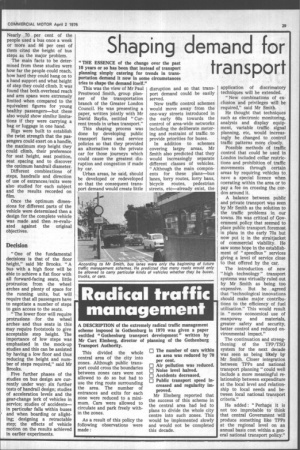Shaping demand for transport
Page 31

If you've noticed an error in this article please click here to report it so we can fix it.
"THE ESSENCE of the change over the past 10 years or so has been that instead of transport planning simply catering for trends in transportation demand it now in some circumstances tries to shape the demand itself.'
This was the view of Mr Paul Prestwood Smith, group planner of the transportation branch of the Greater London Council. He was presenting a paper, written jointly with Mr David Baylis, entitled "Current trends in urban transport."
This shaping process was done by developing public transport fares and service policies so that they provided an alternative to the private car for those journeys which could cause the greatest disruption and congestion if made by car.
Urban areas, he said, should be developed or redeveloped so that the consequent transport demand would create little disruption and so that transport demand could be easily served.
New traffic control schemes would move away from the one-way streets introduced in the early 60s towards the control of area-wide networks including the deliberate metering and restraint of traffic to provide priorities for buses.
In addition to schemes covering larger areas, Mr Smith also predicted that they would increasingly separate different classes of vehicles. "Although the main components for these plans—bus lanes, lorry routes, lorry bans, bicycle routes, pedestrian streets, etc—already exist, the application of discrimatory techniques will be extended.
"New combinations of exclusion and privileges will be required," said Mr Smith.
He thought that techniques such as electronic monitoring, analysis and display equipment, variable traffic signal planning, etc, would increasingly be changed to control traffic patterns more closely.
Possible methods of traffic control that could be used in London included collar restrictions and prohibition of traffic movements through certain areas by requiring vehicles to nave a special licence when ooerating within the area or to pay a fee on crossing the cordon around it.
A balance between public and private transport was seen by Mr Smith as the solution to the traffic problems in our towns. He was critical of Government policy that seemed to place public transport foremost in plans in the early 70s but now put it in the straitjacket of commercial viability. He saw some hope in the establishment of " speedbus " services giving a level of service close to that offered by the car.
The introduction of new "high technology" transport systems was virtually ruled out by Mr Smith as being too expensive. But he agreed that "technological innovations should make major contributions to the efficiency of fuel utilisation." This would result in "more economical use of manpower and materials, greater safety and security, better control and reduced environmental impact."
The continuation and strengthening of the TPP/TSG system for the next decade was seen as being likely by Mr Smith. Closer integration between TPPs and national transport planning "could well include a more meaningful relationship between expenditure at the local level and relationship to local needs and between local national transport criteria."
He added : "Perhaps it is not too improbable to think that central Government will produce something like TPPs at the regional level on an annual basis cost within a general national transport policy."




























































































